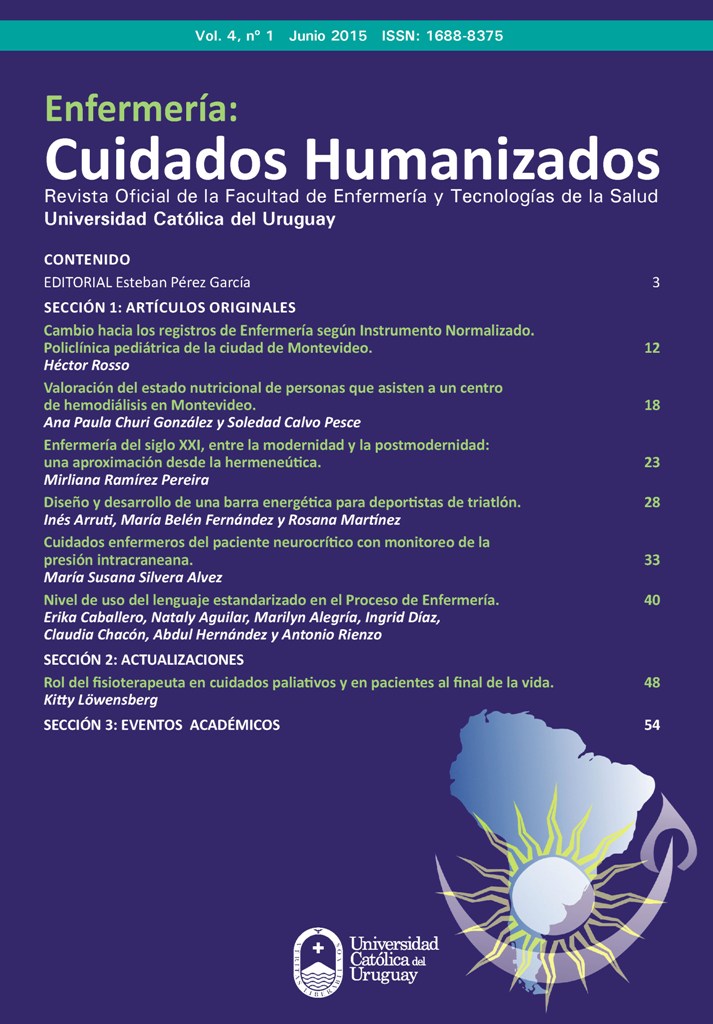NURSING CARE OF THE NEURO-CRITICAL PATIENT WITH INTRACRANIAL PRESSURE MONITORING.
DOI:
https://doi.org/10.22235/ech.v4i1.529Keywords:
Monitoring, Attention in Nursing, Nursing Process, Intracranial PressureAbstract
The aim of this study is to create a standardized nursing-care plan, based on the best scientific evidence that works as a guide for the care of the neuro-critical patient with intracranial pressure monitoring in the intensive care unit. The methodology used is the revision of 59 clinical cases and the process performed to the patients with monitoring for more than ten years of professional practice experience in the Intensive Care Unit. Five basic altered needs were identified according to the Virginia Henderson model, for which seven diagnostic labels were created with their respective interventions and care. We conclude that the Nursing Process allows the nursing discipline to provide care in a rational, logical, and systematic way, preventing the variability in assistance and establishing a common language in caring for the neuro-critical patients.
Downloads
References
Soriano Navarro T. Atención de enfermería al paciente neurocrítico. [Tesis]. Santander: Universidad de Cantabria; 2012.
Disponible en: http://bucserver01.unican.es/xmlui/bitstream/handle/10902/902/SorianoNavarroT.pdf?sequence=1
Carmona J, Gallego J, Llabata P. El paciente neurocrítico: actuación integral de enfermería. Enferm Global. [Internet].2005 May [citado 23 Oct 2014]; (6): 1 – 20. Disponible en:
http://revistas.um.es/eglobal/article/viewFile/502/499.
Maas A, Stocchetti N, Bullock R. Moderate and severe traumatic brain injury in adults. Lancet Neurol. [Internet].2008 Ago [citado 23 Oct 2014]; 7 (8): 728-41. Disponible en: http://www.thelancet.com/journals/laneur/article/PIIS1474-422(08)70164-9/fulltext
Faul M, Xu L, Wald MM, Coronado VG. Traumatic brain injury
in the United States: emergency department visits, hospitalizations
and deaths 2002–2006. Atlanta: Centers for Disease Control and Prevention, National Center for Injury Prevention and Control. [Internet]. 2010 [citado 12 Oct 2014].Disponible en: http://www.cdc.gov/traumaticbraininjury/pdf/blue_book.pdf
Roozenbeek B, Maas A, Menon D. Changing patterns in the
epidemiology of traumatic brain injury. Nat Rev Neurol.[Internet]. 2013 Abr [citado 28 Oct 2014]; 9: 231-236. Disponible en: http://www.nature.com/nrneurol/journal/v9/n4/full/nrneurol.2013.22.html
Saatman KE, Dunaime AC, Bullock R, Maas AI, Valadka A, Manley GT, et al. Classifications of traumatic brain injuries for targeted therapies. J Neurotrauma. [Internet]. 2008 Jul [citado 29 Oct 2014]; 25 (7): 719-38.Disponible en:
http://online.liebertpub.com/doi/pdf/10.1089/neu.2008.0586
Shivaji T, Lee A, Dougall N, McMillan T, Stark C. The
epidemiology of hospital treated traumatic brain injury in Scotland. BMC Neurology. [Internet]. 2014 [citado 29 Set 2014]; 14 (2): 1-7. Disponible en: http://www.biomedcentral.com/content/pdf/1471-2377-14-2.pdf
López Ulloa MO, Atiaja Arias JV. Valor pronóstico del neuromonitoreo inicial en pacientes con trauma craneoencefálico
grave. Metro cienc. 2008 Jul; 17 (2): 411-415.
Parekh AK, Barton MB. The challenge ofmultiplecomorbidity
for the US healthcaresystem. JAMA [Internet]. 2010 Abr [citado 04 Nov 2014]; 303 (13): 1303–1304. Disponible en: http://amaprod.silverchaircdn.com/data/Journals/JAMA/4506/jco05031_1303_1304.pdf.gif
Calderón C, Rodríguez G, López R, García A, Ramírez R.
Intervenciones de enfermería en la atención del adulto con traumatismo craneoencefálico grave. México DF: Secretaría de Salud; 2013 [Internet]. [citado 04 Nov 2014]. Disponible en: http://www.cenetec.salud.gob.mx/descargas/gpc/CatalogoMaestro/IMSS_604_13_ENFERMERIAENTRA UMACRA NEOENCEFAL ICO/604GER.pdf
Costanti Settervall CH, Cardoso de Sousa RM, Fürbringer
ES. Escala de coma de Glasgow más primeriras 72 horas após trauma cranioencefálico e mortalidadehospitalar.Rev Lat Am Enfermagem. [Internet]. 2011 Nov [citado 7 Nov. 2014]; 19 (6): 1-7. Disponible en: http://www.scielo.br/pdf/rlae/v19n6/pt_09.pdf
Matis G, Birbilis T. The Glasgow Coma Scale--a brief review.
Past, present, future. Acta Neurol Belg. 2008 Set; 108 (3):
-89.
Bárcena-Orbe A, Rodríguez-Arias CA, Rivero-Martin B, Cañizal-García JM, Mestre-Moreiro C, Calvo-Peréz JC, et al. Revisión del traumatismo craneoencefálico. Neurocirugía.[Internet]. 2006 [citado 08 Nov 2014]; 17: 495-518. Disponible en: http://scielo.isciii.es/pdf/neuro/v17n6/1.pdf?origin=publication_detail
López Díaz C. Paciente neurocrítico: cuidados de enfermería.
Rev. Rolenferm. 2009; 32 (12): 841-850.
Zepeda M, Vásquez A, Silveira E. Traumatismos causados
por el tránsito y discapacidad. Washington: Organización
Panamericana de la Salud, 2011. [Internet].[citado 08 Nov 2014]. Disponible en: http://www.paho.org/hq/index.php?option=com_docman&task=doc_view&gid=20910&Itemid
Siniestralidad vial en Uruguay informe 2012. Unidad Nacional
de Seguridad Vial UNASEV. Montevideo: UNASEV; 2015.[Internet] [actualizado 2015; citado 10 Nov 2014]. [50 p.].Disponible en: http://unasev.gub.uy/wps/wcm/connect/cf0a02804fc6a03cb2d3f7deba2def97/InformeSiniestralidadVialUruguay_2012.pdf?MOD=AJPERES&CONVERT_TO=url&CACHEID=cf0a02804fc6a03cb2d3f7deba2def97
Montforte C, Urdangarín J. Atención de enfermería al paciente
neurotraumático. En: Gómez Ferrero, O. Manual de enfermería en cuidados intensivos: enfermería de cuidados intensivos médico-quirúrgicos. Madrid: Monsa-Prayma; 2008. p. 243-287.
Diagnósticos Enfermeros: definiciones y clasificación 2009-2011. North American Nursing Diagnosis Association (NANDA) Internacional. Barcelona: Elsevier; 2010.
Johnson M, Bulechek G, McCloskey J, Maas M, Moorhead
S, Butcher H, Swanson E. Interrelaciones NANDA, NOC y NIC. 2ª ed. Madrid: Elsevier; 2006.
McCloskey J, Bulechek G. Clasificación de intervenciones de enfermería (NIC). 4ª ed. Madrid: Elsevier; 2005.
Moorhead S, Johnson M, Maas M. Clasificación de resultados
de enfermería (NOC). 3ª ed. Madrid: Elsevier; 2005.
Downloads
Published
How to Cite
Issue
Section
License
Copyright (c) 2015 Enfermería: Cuidados Humanizados

This work is licensed under a Creative Commons Attribution 4.0 International License.

















